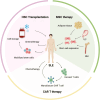Current cell therapies for systemic lupus erythematosus
- PMID: 38920310
- PMCID: PMC11386214
- DOI: 10.1093/stcltm/szae044
Current cell therapies for systemic lupus erythematosus
Abstract
Systemic lupus erythematosus (SLE) is a chronic autoimmune disease in which multiple organs are damaged by the immune system. Although standard treatment options such as hydroxychloroquine (HCQ), glucocorticoids (GCs), and other immunosuppressive or immune-modulating agents can help to manage symptoms, they do not offer a cure. Hence, there is an urgent need for the development of novel drugs and therapies. In recent decades, cell therapies have been used for the treatment of SLE with encouraging results. Hematopoietic stem cell transplantation, mesenchymal stem cells, regulatory T (Treg) cell, natural killer cells, and chimeric antigen receptor T (CAR T) cells are advanced cell therapies which have been developed and evaluated in clinical trials in humans. In clinical application, each of these approaches has shown advantages and disadvantages. In addition, further studies are necessary to conclusively establish the safety and efficacy of these therapies. This review provides a summary of recent clinical trials investigating cell therapies for SLE treatment, along with a discussion on the potential of other cell-based therapies. The factors influencing the selection of common cell therapies for individual patients are also highlighted.
Keywords: cell therapy; chimeric antigen receptor T-cell therapy; clinical trial; hematopoietic stem cell transplantation; mesenchymal stem cell therapy; systemic lupus erythematosus.
© The Author(s) 2024. Published by Oxford University Press.
Conflict of interest statement
The authors declare no potential conflicts of interest.
Figures



References
Publication types
MeSH terms
LinkOut - more resources
Full Text Sources
Medical

